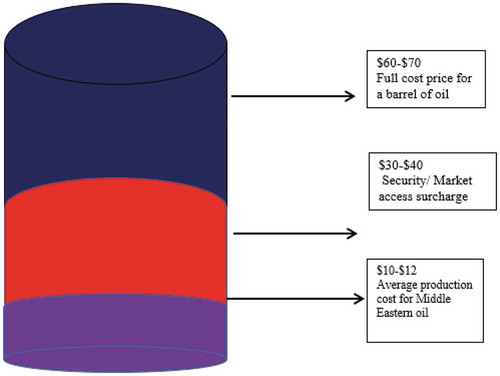Globalization has prompted nations to forge economic links with their former political antagonists. This has made it difficult for a country to follow a course that is unacceptable to its trading strategic partners. In today’s world of economic realism and political pragmatism, ideals in and of themselves are not enough; in order for political decisions to make sense, they must be cost effective as well.
The attack on two oil tankers in the Gulf of Oman and the Strait of Hormuz, coupled with the prior attacks on four other tankers added uncertainty regarding global oil supplies and consumer prices at the pump.
Global oil markets need the Strait of Hormuz to remain open and conflict free. An estimated 17 million barrels of oil per day are transported through the Strait under the eyes of the US Navy’s Fifth Fleet. This represents an estimated 35% to 40% of global oil supplies destined to Asian consumers – China, Japan, Korea, and India – and other global consumers among G20 countries. According to President Trump, China’s dependency on Middle Eastern oil imports are estimated to represent about 90% of China’s oil needs. Japan’s oil imports are estimated at 62%. India, Korea, and Singapore are also dependent on Middle Eastern oil supplies. President Trump labeled these oil market sales between Gulf oil producers and other consumers as “free rider” transactions.
Currently, the US is the leading global oil producer at over 11mbd, and we are less dependent on Middle Eastern oil than some of our leading Asian competitors. The US is the largest global oil consumer at an estimated 19mbd, out of a global daily oil market estimated at 95mbd. To guarantee the free transport of oil through the Strait of Hormuz, a new multilateral agreement is needed. The G20 should call for a new “Gulf Oil Security and Market Access Protocol on Oil and Natural Gas Exports.”
The estimated production cost of a barrel of oil from the Gulf oil producers is less than $12/barrel. Adding a USD 30 – USD 40 surcharge for Persian oil exports would represent a true price for Persian Gulf oil exports. This market access security surcharge, if paid for by all Persian Gulf oil exporting countries, including Iran, could create a stable floor for the price of oil and reduce risk, stabilize the market, and provide certainty for global oil consumers. This could represent an oil price framework at an estimated $60 – $70/barrel and would truly reflect the cost of a traded barrel of Gulf oil and could be a marker for Brent and WTI oil trade. This should apply to Arab oil exports and those of Iran, the latter who would pay this surcharge and could then join global oil exporters.
This suggested price framework could represent a new business model for pricing Gulf oil that incorporates both the production costs and the market access and risks and could help stabilize global oil prices. Moreover, this could create a win-win situation for US oil producers, including shale, and help protect US vital and strategic interests. Currently, the security costs for Persian oil exports are being borne by US taxpayers. This new pricing would mitigate the “free rider” advantage of all the current Gulf oil exporters. This assertive, sure-footed multilateral US policy could leverage US economic strength and its standing in global oil markets and enhance the United States’ political ability to work with other OECD and G20 countries. Equally, this would help protect US vital and strategic interests. The following figure illustrates the full cost breakdown for a barrel of oil:
Moreover, a multilateral G20 approach would represent collective action that would also indicate to Iran that its best interest lies in working with all G20 countries and other oil importers.
Today, politics and economics are intertwined. The power of economic and business linkages can positively influence the global political landscape and force both Middle Eastern oil producers, including Iran, and worldwide oil importers to build more functional and successful arrangements to resolve political conflicts.
As many of us have started new semesters and, possibly, new scholarly endeavors, we here at the Journal of Asia-Pacific Business would like to welcome and encourage your progress. While the publication process may seem a bit more automated, we are determined to maintain the high academic quality for which we have always striven. To aid your pursuits, we offer these four articles.
Our first article, “Individualism, Collectivism and Management in China: Does Atlas Shrug in China?” by Zhang Long of China University of Geosciences, John A. Parnell of University of North Alabama, and Eric B. Dent of Florida Gulf Coast University is an interesting examination of the influence of Ayn Rand on Chinese management practices. Our second article is “The Contingent Value of Entrepreneurs’ Political Capital: Evidence from China,” by Juan Ling of Georgia College and State University, Lei Xu of Texas Tech University, and Weiqi Zhang of Suffolk University. This article assesses the influence of political and social mobility capital on entrepreneurs and finds a contingent influence.
Our third article, “Moderating Effect of Perceived Organizational Support on Human Resource Development Practices and Organizational Citizenship Behavior,” is by Suteera Detnakarin and Suthinee Rurkkhum of Prince of Songkhla University. It looks at the positive effects of supportive human resource management on corporate culture in the service industry. Our fourth article of this issue, “New Evidence of Market Competition in the Japanese Tire Industry using Market Share Analysis,” by Craig Parsons of Yokohama National University, Xuan Dong Nguyen of Vietnam National University, and Xavier de Vanssay of York University analyzes an historical, industrial rivalry in Japan.
Finally, we again offer our most gracious appreciation for all of our submitters, reviewers, and readers. It is your combined efforts that sustain us.

